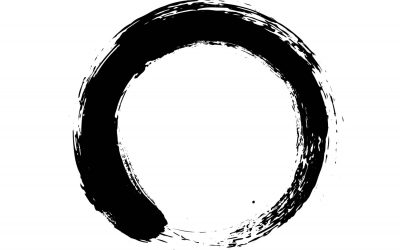Beginning Zen Meditation Instruction (Zazen).
Traditional teachings say that a quiet place should be selected for practicing Zazen. This should not be understood in a superficial, external way. What is meant by “quiet place” is that we ourselves should manifest quietness. So, in that sense, Zazen can be practiced anywhere, even in a restaurant or night club. The formal instructions for “Zazengi” (written 800 years ago) were rather simplistic then and less appropriate for our era now.
In recent times, more specific suggestions have emerged to assist Zazen. First, there is the matter of position and posture. Generally a cushion should be used to raise one’s buttocks above the floor mat to about the height of one’s fist. The posture should be such that your hands can be extended beyond your knees. Both of the knees should rest firmly on the floor mat. If you cannot easily grasp your knees, a larger cushion or second cushion should be used. The hands should be raised to encircle the navel; leaving space between the arms and the torso. We should imagine that we are holding some kind of jewel in the palm of our hands. If we do this we shall have energy in our Zazen. But if we let the hands drop our Zazen will be very light.
If we are more interested in what we could see at the movies we can let our hands drop. But if we are interested in discovering how to fully manifest, then we must keep our hands raised. The hands should be firmly joined, not barely held together. The right hand definitely supports the left hand. The thumbs touch lightly and there should be strength in the little fingers.
Now, once we reach this point we should find a balance by rocking from side to side until we discover a position where the spine is straight. Our posture should be such that the tip of the nose is in a perpendicular line with the navel. Then a triangle is formed: the navel as the apex and the knees as supports. So, just as the nose and the navel are in a perpendicular relationship to each other, the ears and the tips of the shoulders should also be in a line. The line of sight should follow the angle of the bridge of the nose and hit the floor at whatever point it comes.
Once the position is settled, we can turn our attention to breathing. First we exhale. The exhalation is such that the breath arises with energy from the lower abdomen. The lower abdomen should be quite relaxed and con-sequently full of energy. If this is done properly the solar plexis becomes quite still. With a powerful ex- halation, we exhale all thoughts, no matter how attractive or unattractive. Next we inhale, and in the inhalation phase we realize that we breathe in the whole universe. We allow the lower abdomen to relax to such an extent that it naturally falls and extends forward. In the inhalation phase the sternum is up while the abdomen is out. This is totally silent breathing. The solar plexis remains quite still. In the inhalation phase we realize that we inhale the whole world. In the exhalation phase we exhale the whole world. This particular type of breathing is very difficult to do in a standing position but while sitting it is relatively easy. In just a few cycles of breathing we experience a very deep sense of tranquility. If you find this is not the case then you are not breathing properly; your thinking keeps you from realizing the breath cycle.
Let’s say, for example, we find we are feeling disturbed by the sound of a bird. In this case we should merely inhale to accept the sound of the bird, and exhale, giving the song back to the bird. In other words, we breathe in harmony with the bird. Or, say a car passes. In this case our sitting should be such that we can dissolve into the sound of the car when it becomes a bother. As our practice deepens, no matter what happens, whether it be a car, or a bird, or any other thing which could be called a disturbance, it will no longer disturb. Doing Zazen in such a manner will bring a realization that there is no separation, that we unite and dissolve with everything at all times. We then come to the realization that the one who disturbs is none other than ourself.
To keep saliva from becoming a problem, we rest the tongue behind the upper teeth, more or less filling our mouth with the tongue so that saliva will not build up. If we do this, the mouth will naturally draw down at the corners, and the nostrils will flare. In my teaching I frequently refer to the activity of horses in the spring. A stallion will flare his nostrils and whinny and snort. Hearing this, the mare will flare her nostrils as well. We should do likewise when we sit.
Your sitting should be full of life, full of energy, the nostrils flared, the lower abdomen relaxed, naturally protruding down and forward. There should also be energy in your hands, especially in the little fingers and energy in the toes. The eyes should not be shut but half open so we can actually see, and no matter what occurs we realize it and are in agreement with it. This is a self-negating practice, and as we mature we come to an insight as to what this self-negation is. Consequently we also develop a deeper insight into what self-affirmation is. For example, hearing the sound of a car and then thinking “there is the sound of a car” is clearly the activity of self-affirmation. What is often called “meditation” nowadays is merely reinforcing a subjective sense, a feeling of well-being without any further insight about self-affirmation and self-negation.
If we sit the proper way, we will inevitably fall into moments of complete thoughtlessness. This is a situation where no experiencer is present. It is a momentary event and generally we are not even aware of it. Let’s say, for instance, that two people are in love. When they kiss, in the instant of kissing they both dissolve completely into forgetfulness. But, at the same time, there must be awareness so that the kissing has life and energy. In other words, God or Buddha or the Absolute is not aware in any way of kissing. But the human situation is different in that we must realize when we are kissing. This is a vital capability. Our Zazen, in the same way, must be such that we develop clear insight into our own activity, so that we can recognize the events of self-affirmation and negation.
In some Zen instructions we may encounter the simplistic suggestion that we stop thinking. Now if that were sufficient, rather than holding an erect siting position we could just as well drink a bottle of wine and go to sleep. In the instantaneous moments that lie between affirmation and negation there is a state of consciousness, but it is extremely brief. What occurs there is thoughtlessness but since it is so brief it is very difficult to develop insight about it.
If our practice is going to be a living Zen, it is very important to cultivate insight about this cyclic activity of self-negation and self-affirmation, and to achieve further insight about the state of thoughtlessness that occurs so briefly in between. We should endeavor to cultivate the kind of Zazen which does not strive for forced tranquillity and does not manifest false notions of which we really have no clear insight.
For more articles about beginning Zen meditation instruction or zazen practice, click here.




